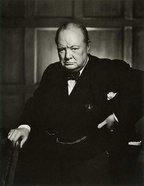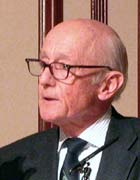Prime Minister
|
|
A prime minister may be either:
- the chief or leading member of the cabinet of the top-level government in a country having a parliamentary system of government; or
- the official, in countries with a semi-presidential system of government, appointed to manage the civil service and execute the directives of the President.
In parliamentary systems like the British Westminster system, the prime minister is the head of the government while the position of head of state is largely ceremonial. In some monarchies the prime minister exercises powers (known as the Royal Prerogative) which are constitutionally vested in the Crown and can be exercised without the approval of parliament. As well as being Head of Government, a prime minister may have other roles or titles—the Prime Minister of the United Kingdom, for example, is also First Lord of the Treasury. Prime ministers may take other ministerial posts—for example during the Second World War Winston Churchill was also Minister of Defence.
| Contents |
Prime ministers in republics and in monarchies
The post of prime minister is one which may be encountered both in constitutional monarchies (such as Belgium, Denmark, Japan, the Netherlands, Norway, Spain, and the United Kingdom), and in republics in which the head of state is an elected or unelected official with varying degrees of real power. This contrasts with the presidential system, in which the President (or equivalent) is both the head of state and the head of the government. See also "First Minister" and "Premier": alternative titles usually equivalent in meaning to "prime minister."
In some presidential or semi-presidential systems such as those of France, Russia, South Korea, or Taiwan the prime minister is an official generally appointed by the President but approved by the legislature and responsible for carrying out the directives of the President and managing the civil service. In these systems, it is possible for the president and the prime minister to be from different political parties if the legislature is controlled by a party different from that of the president. When it arises, such a state of affairs is usually referred to as (political) cohabitation.
Entry into office
In parliamentary systems a prime minister can enter into office by a number of means.
- by appointment by the head of state without the need for confirmation by parliament; Example: The United Kingdom, where the monarch appoints a prime minister without the need for confirmation from parliament, which gets its first chance to indicate its view on the new government in the vote on the Speech from the Throne, in which the new government outlines its legislative programme. The method of prime ministerial appointment by the British sovereign is known as Kissing Hands.
- appointment by the head of state after parliament nominates a candidate; Example: The Republic of Ireland where the President of Ireland appoints the Taoiseach on the nomination of the Dáil Éireann.)
- appointment by the head of state after the majority parliamentary party nominates a candidate; Example: the Australian federal government, Canada, India, and New Zealand.
- the head of state nominates a candidate for prime minister who is then submitted to parliament for approval before appointment as prime minister; Example: Spain, where the King sends a nomination to parliament for approval. Also Germany where under the Basic Law (constitution) the Bundestag votes on a candidate nominated by the Federal President. In these cases, parliament can choose another candidate who then would be appointed by the head of state.)
- the head of state appoints a prime minister who has a set timescale within which s/he must gain a vote of confidence; (Example: Italy.)
- direct election by parliament (the premiers of the Northwest Territories and Nunavut);
- direct election by the public (Example: Israel, 1996-2001.); The Prime Minister is elected in a general election, with no regard to political affiliation.
- appointment by a state office holder other than the head of state or his/her representative; Example: Under the modern Instrument of Government 1974, which came into force in 1975, the power of commissioning someone to form a government was moved from the Monarch of Sweden to the Speaker of Parliament, who, once it has been approved, formally makes the appointment.
Though most prime ministers are 'appointed', they are generally, if inaccurately, described as 'elected'.
Prime ministers and constitutions
The position, power and status of prime ministers differ depending on the age of the constitution in individuals.
Britain's constitution, being uncodified and largely unwritten, makes no mention of a prime minister. Though it had de facto existed for centuries, its first official mention in official state documents did not occur until the first decade of the twentieth century.
Australia's Constitution makes no mention of a prime minister of Australia. The office has a de facto existence at the head of the Executive Council.
Ireland's constitution, Bunreacht na hÉireann (1937) provided for the office of taoiseach in detail, listing powers, functions and duties.
Germany's Basic Law (1949) lists the powers, functions and duties of the federal Chancellor.
Exit from office
Contrary to popular and journalistic myth, most prime ministers in parliamentary systems are not appointed for a specific term of office and in effect may remain in power through a number of elections and parliaments. For example, Margaret Thatcher was only ever appointed prime minister on one occasion, in 1979. She remained continually in power until 1990, though she used the assembly of each House of Commons after a general election to reshuffle her cabinet. Some states, however, do have a term of office of the prime minister linked to the period in office on the parliament. Hence the Irish Taoiseach is formally 'renominated' after every general election. (Some constitutional experts have questioned whether this process is actually in keeping with the provisions of the Irish constitution, which appear to suggest a taoiseach should remain in office, without the requirement of a renomination, unless s/he has clearly lost the general election.) The position of Prime Minister is normally chosen from the political party that commands majority of seats in the lower house of parliament.
In parliamentary systems, governments are generally required to have the confidence of the lower house of parliament (though a small minority of parliaments, by giving a right to block Supply to upper houses, in effect make the cabinet responsible to both houses, though in reality upper houses, even when they have the power, rarely exercise it). Where they lose a vote of confidence, have a motion of no confidence passed against them, or where they lose Supply, most constitutional systems require either:
a) a resignation or
b) a request of a parliamentary dissolution.
The latter in effect allows the government to appeal the opposition of parliament to the electorate. However in many jurisdictions a head of state may refuse a parliamentary dissolution, requiring the resignation of the prime minister and his or her government. In most modern parliamentary systems, the Prime Minister is the person who decides when to request a parliamentary dissolution. Older constitutions often vest this power in the cabinet. (In Britain, for example, the tradition whereby it is the prime minister who requests a dissolution of parliament dates back to 1918. Prior to then, it was the entire government that made the request. Similarly, though the modern 1937 Irish constitution grants to the Taoiseach the right to make the request, the earlier 1922 Irish Free State Constitution vested the power in the Executive Council (the then name for the Irish cabinet).
Alternative titles
A number of different terms are used to describe prime ministers. The German prime minister is actually titled "Federal Chancellor" while the Irish Prime Minister is called the Taoiseach. In many cases, though commonly used, "prime minister" is not the official title of the office-holder; the British prime minister is (usually) "First Lord of the Treasury and Minister for the Civil Service", and the Spanish prime minister is the "President of the Government" (Presidente del Gobierno). Other common forms include president (or chairman) of the Council of Ministers (for example in Italy, as Presidente del Consiglio dei Ministri), or of the Executive Council (&c.), or "Minister-President".
Articles on prime ministers
- Prime Minister of Australia
- Chancellor of Austria
- Prime Minister of Canada
- Prime Minister of Newfoundland
- Prime Minister of France
- Prime Minister of Fiji
- Chancellor of Germany
- Prime Minister of India
- Prime Minister of Iran
- Taoiseach of Ireland
- Prime Minister of Israel
- Prime Minister of Japan
- Prime Minister of Malaysia
- Prime Minister of the Netherlands
- Prime Minister of New Zealand
- Prime Minister of Pakistan
- Prime Minister of Serbia
- President of the Government of Spain
- Prime Minister of Sweden
- Prime Minister of the United Kingdom
Lists of prime ministers
The following table groups the list of past and present prime ministers and details information available in those lists.
See also
- Chancellor
- List of democracy and elections-related topics
- President
- Monarch
- Governor-General
- Head of state
- List of national leaders
- Heads of state timeline
External links
- website of the Prime Minister of Australia (http://www.pm.gov.au/)
- website of the Prime Minister of Barbados (http://www.primeminister.gov.bb/)
- website of the Prime Minister of Belgium (http://www.premier.fgov.be/)
- website of the Prime Minister of Canada (http://pm.gc.ca/)
- website of the Prime Minister of France (http://www.premier-ministre.gouv.fr/en/)
- website of the Prime Minister of the Hellenic Republic (Greece) (http://www.primeminister.gr/gr/)
- website of the Prime Minister of Hungary (http://www.kormany.hu/archivum/index.en.html)
- website of the Prime Minister of Iceland (http://government.is/interpro/for/for.nsf/pages/raduneytid_ensk.html)
- website of the Prime Minister of India (http://pmindia.nic.in)
- website of the Taoiseach of Ireland (http://www.taoiseach.gov.ie/index.asp)
- website of the Prime Minister of Israel (http://www.pmo.gov.il/)
- website of the Prime Minister of Japan (http://www.kantei.go.jp/foreign/index-e.html)
- website of the Prime Minister of South Korea (http://www.opm.go.kr/ehtml/)
- website of the Prime Minister of Malaysia (http://www.pmo.gov.my)
- website of the Prime Minister of The Netherlands (http://www.ministerpresident.nl/)
- website of the Prime Minister of New Zealand (http://www.primeminister.govt.nz/)
- website of the Prime Minister of Norway (http://odin.dep.no/smk/engelsk/index-b-n-a.html)
- website of the Prime Minister of Poland (http://www.kprm.gov.pl/)
- website of the Chairman of Serbia and Montenegro Council (http://www.predsednik.gov.yu/)
- website of the President of the Government of Spain (http://www.la-moncloa.es/webIngles/asp/inicio.asp)
- website of the Prime Minister of Thailand (http://www.pmoffice.go.th)
- website of the Prime Minister of Trinidad and Tobago (http://opm.gov.tt/)
- home page of 10 Downing St, residence & office of the Prime Minister of the UK (http://www.pm.gov.uk/output/Page1.asp)ca:Primer ministre
cs:PÅedseda_vlády de:Premierminister et:Peaminister es:Primer Ministro fi:Pääministeri fr:Premier ministre he:ר×ש_××ש×× hu:Miniszterelnök id:Perdana Menteri ja:首相 ka:პრემიერ-მინისტრი nl:Premier no:Premierminister pl:Premier pt:Primeiro-ministro simple:Prime Minister sv:Premiärminister th:นายกรัฐมนตรี zh:首相





